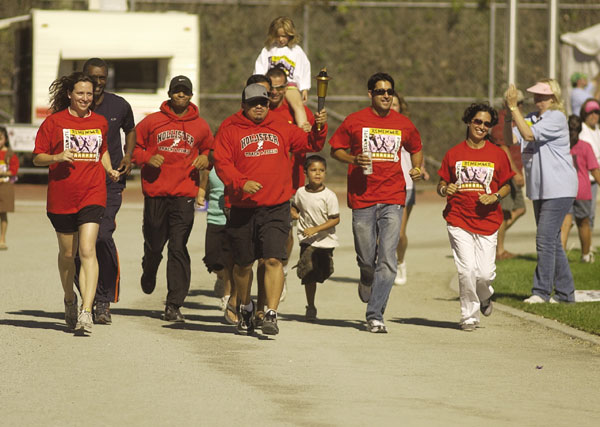
The conductor takes the podium as the house lights dim. He
pauses for a moment and takes a deep breath, raising his baton. The
musicians respond, placing their instruments at the ready. In the
audience, the last cough has died away and the last program has
stopped rustling. The audience is quiet in anticipation of the
first note. All is still. Then, in one motion, the conductor’s
baton hits the first downbeat, and the symphony is off and
running.
The conductor takes the podium as the house lights dim. He pauses for a moment and takes a deep breath, raising his baton. The musicians respond, placing their instruments at the ready. In the audience, the last cough has died away and the last program has stopped rustling. The audience is quiet in anticipation of the first note. All is still. Then, in one motion, the conductor’s baton hits the first downbeat, and the symphony is off and running.
This moment is the culmination of hours of individual practice sessions and group rehearsals by the all-volunteer South Valley Symphony, a group that has replayed this scene time and again since the symphony performed its first concert for 35 people in December 1974.
But the symphony’s stated mission of promoting local talent and serving the cities of Morgan Hill, Gilroy and Hollister has become more and more difficult to realize recently. “The problem with all symphonies … it’s a challenge to get the younger people interested. Watching a concert is a passive activity, and in this age of computers, sitting for 90 minutes is not something that’s normally done,” said John Graham, vice president of the symphony’s board of directors.
So what has kept the symphony going for so long when iPods and video games seemingly rule our lives?
“Whatever it is that’s kept it going will probably keep it going,” Graham said, citing free concerts as just one way to introduce new audiences to the group. “Seventy to 80 percent of our audiences are regular attendees. When we get people exposed, say, at a free concert if they’re never seen one before, our other 20 percent come from those concerts.” Concerts like the June 8 Mission San Juan Bautista performance featuring works from the operas “Carmen” and “La Traviata” are designed to reign in new audiences with familiar music and give regular subscribers something different than the standard concert hall performance.
The demands of being in a community orchestra are different from professionals as well. Whereas professionals practice one to two hours every day, with performances three to four times a week, Beverly Olivier-Blount, the symphony’s principal violinist, also known as the concertmaster – who is a registered nurse – usually practices four or five times a week to keep her skills sharp. “It’s not the number of times you practice; it’s the kind of practice you do,” she said.
Olivier-Blount said that the symphony is a vital part of the local scene. “I love it that a part of the community is this wonderful symphony with wonderful conductors. I’m proud to be where I am.”
For the people in the audience, supporting local arts groups goes hand-in-hand with hearing good music. Carolyn Schiltz, 65, who recently moved to Los Banos from Gilroy, has been a season ticket holder since the early 1980s.
“I moved here from Nebraska,” she said. “I’d never been to a symphony before I moved to California. (The symphony) opened up a whole new world of music for me.” Schiltz said she loves the dedication of the musicians and what each different conductor brings to the table. “The different personalities of the different conductors when they direct the orchestra … every program is an absolute delight,” she said. Schiltz is well aware of the major symphonies in the area, but says, “I’ve never considered going to San Jose or San Francisco. There’s so much available in the South Valley if you only take advantage of it.”
Olivier-Blount said that the symphony’s audiences are “very loyal,” but would like to see younger people coming to the performances. “There are some young people there, but most of the audience is from 30 on up,” she said. She suggested bussing schoolchildren to performances as a way of planting a seed in younger audiences. “As a child in Los Angeles, we were bussed to the Dorothy Chandler Pavilion to listen to the symphony every year. It brought music into my life,” she said.
While keeping audiences is a vital part of the group’s operations, there are internal challenges as well. Tony Quartuccio, the symphony’s conductor who is finishing his second season with the group, says that recruiting – and keeping – musicians is as challenging as retaining an audience.
“Low strings – cellos and string basses – are a serious issue,” he said. “We haven’t yet been successful in creating an environment that will sustain them.”
Graham, speaking about the symphony’s personnel, added “It’s hard to get people to make the initial commitment, but once they do, they tend to stay with us.”
However, with all the challenges facing the group, both Graham and Quartuccio are hopeful about the symphony’s future.
“The main audience comes from Gilroy, Morgan Hill and San Martin, but we’ve had increasing numbers in our audiences since Tony became director. We’re getting lots of people from San Jose now as well because of the work he’s done up there,” he said, citing Quartuccio’s continuing conducting work with Opera San Jose and the San Jose Chamber Orchestra as a draw for audiences. When asked where he sees the group in five to 10 years, Graham responded, “The group will keep expanding. I’m absolutely amazed that we can keep going.”
Quartuccio takes a two-tiered approach to his outlook for the group.
“The first major area for growth is making every section improve within itself. We feature each group individually, like the brass or strings. Building an orchestra through a nucleus is a very powerful tool. The musicians know they’re more responsible and there’s more ownership. When they know they’re on the hook, they rise up.
“The second level is to do one or two major symphonic works every season. This year’s piece is Gershwin’s ‘Rhapsody in Blue’ with a piano soloist,” he said. The Gershwin piece was performed at the symphony’s most recent concert Saturday. Quartuccio is also looking forward to the symphony’s June 8 concert, when some of his friends from Opera San Jose will be joining the symphony.
Quartuccio revealed some of the works planned for next season.
“It’s still in the early stages,” he said, but mentioned the first concert – a program of Latin music featuring Ravel’s “Bolero” and mariachi music – will take place in September, with a preview concert at a local winery that has yet to be confirmed. The symphony also will perform its annual holiday concert in December, and the Spring 2009 concert will be what Quartuccio calls a “soloist feature concert.” Among the works planned are Mozart’s Symphony No. 1, and Prokofiev’s “Classical” Symphony. The final performance of the season will once again take place at Mission San Juan Bautista, and will feature works by Respighi and Schumann, as well as Tchaikovsky’s “Romeo and Juliet.”
Q & A with South Valley Symphony Conductor Anthony Quartuccio
Q: How long have you been conductor of the symphony?
A: I’m finishing up my second season. I came in as a guest conductor when Henry Mollicone was transitioning out. Instead of doing a search, they offered me the position.
Q: How much did you know about the symphony before you took the position?
A: Not a whole lot. I knew it existed for over 30 years. I heard a lot of feedback from Henry Mollicone, and I had heard the group play a few times. Sometimes, not knowing a whole lot is actually an advantage.
Q: What other conducting work have you done?
A: I work with Opera San Jose, conducting at least two productions each year. I’m also the assistant conductor of the San Jose Chamber Orchestra, and I teach college-level music theory to schoolchildren in Palo Alto.
Q: What drew you to the symphony?
A: I saw the potential for growth, a chance for infusing new energy. I also enjoy community orchestras. They’re logistically difficult, but it’s a leadership job with a very strong teaching component. You don’t get that in the professional world. I love the idea that in rehearsals I can stop and have a little discourse about style or a specific aspect of performance. With professional musicians, they don’t want to hear any of that. You show up, you perform, and you go home. Plus, there’s a geographical convenience, since it’s in my back yard.
Q: Aside from studying the score for each piece you conduct, what do you do on a personal level to prepare for a performance?
A: It’s a question of relaxing. You have to be well prepared because with a community orchestra, there are lots of logistical issues that can throw you off course.
Being in good physical and mental shape, and focusing on the music. It’s important to be physically, mentally, and even spiritually focused on the music.









